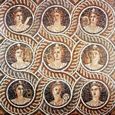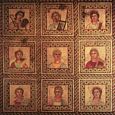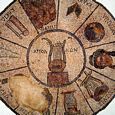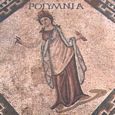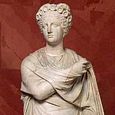POLYMNIA
Greek Name
Πολυμνια
Transliteration
Polymnia
Latin Spelling
Polyhymnia
Translation
Many Hymns
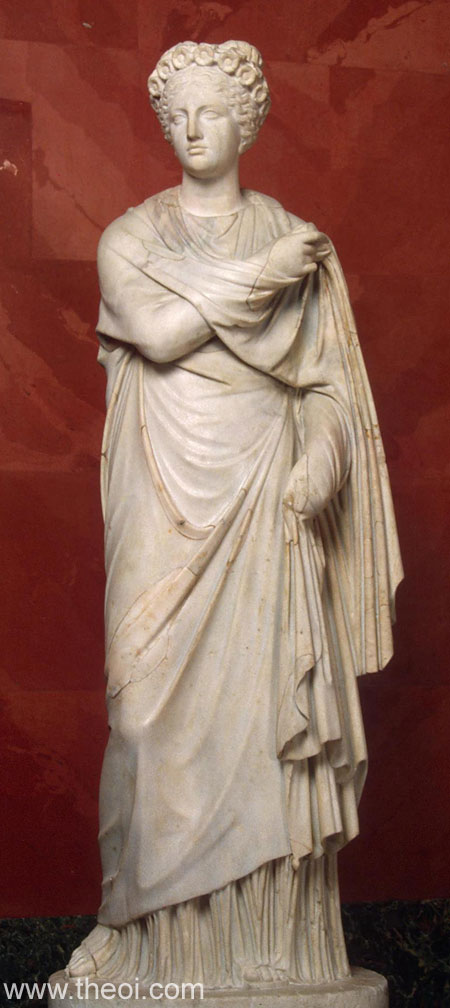
POLYMNIA (Polyhymnia) was one of the nine Mousai (Muses), the goddesses of music, song and dance. In the Classical era, when the Mousai were assigned specific artistic and literary spheres, Polyhymnia was named Muse of religious hymns and portrayed as a woman in a pensive or meditative pose. Her name was derived from the Greek words poly- "many" and hymnos "praise" or "hymn."
FAMILY OF POLYMNIA
PARENTS
ZEUS & MNEMOSYNE (Hesiod Theogony 75, Apollodorus 1.13, Diodorus Siculus 4.7.1, Orphic Hymn 76)
ENCYCLOPEDIA
POLY′MNIA or POLYHY′MNIA (Polumnia), a daughter of Zeus, and one of the nine Muses. She presided over lyric poetry, and was believed to have invented the lyre. (Hes. Theog. 78; Schol. ad Apollon. Rhod. iii. 1.) By Oeagrus she became the mother of Orpheus. (Schol. l. c. i. 23.) In works of art she was usually represented in a pensive attitude.
Source: Dictionary of Greek and Roman Biography and Mythology.
CLASSICAL LITERATURE QUOTES
Hesiod, Theogony 75 ff (trans. Evelyn-White) (Greek epic C8th or C7th B.C.)
:
"The Mousai (Muses) sang who dwell on Olympos, nine daughters begotten by great Zeus, Kleio (Clio) and
Euterpe, Thaleia (Thalia), Melpomene and Terpsikhore (Terpsichore), and Erato and Polymnia (Polyhymnia) and
Ourania (Urania) and Kalliope (Calliope)."
Pseudo-Apollodorus, Bibliotheca 1. 13 (trans. Aldrich) (Greek mythographer C2nd A.D.)
:
"Mnemosyne [bore to Zeus] the Mousai (Muses), the eldest of whom was Kalliope (Calliope), followed by Kleio
(Clio), Melpomene, Euterpe, Erato, Terpsikhore (Terpsichore), Ourania (Urania), Thaleia (Thalia), and
Polymnia."
Orphic Hymn 76 to the Muses (trans. Taylor) (Greek hymns C3rd B.C. to 2nd A.D.)
:
"Daughters of Mnemosyne and Zeus . . . Kleio (Clio), and Erato who charms the sight, with thee, Euterpe,
ministering delight: Thalia flourishing, Polymnia famed, Melpomene from skill in music named: Terpsikhore
(Terpsichore), Ourania (Urania) heavenly bright."
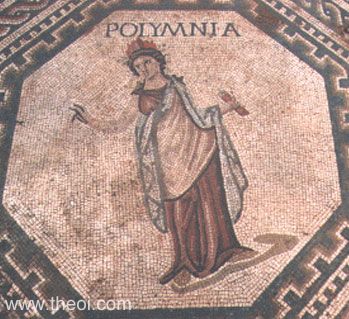
Diodorus Siculus, Library of History 4. 7. 1 (trans. Oldfather) (Greek historian C1st
B.C.) :
"Hesiod even gives their [the Muses'] names when he writes : ‘Kleio, Euterpe, and Thaleia, Melpomene,
Terpsikhore and Erato, and Polymnia, Ourania, Kalliope too, of them all the most comely.’
To each of the Mousai (Muses) men assign her special aptitude for one of the branches of the liberal arts, such
as poetry, song, pantomimic dancing, the round dance with music, the study of the stars, and the other liberal
arts . . . For the name of each Mousa (Muse), they say, men have found a reason appropriate to her: . . .
Polymnia (Polyhymnia), because by her great (polle) praises (humnesis) she brings distinction
to writers whose works have won for them immortal fame."
Ovid, Fasti 5. 9 ff (trans. Frazer) (Roman poetry C1st B.C. to C1st A.D.)
:
"Declare to me, ye [the Mousai (Muses)] who haunt the springs of Aganippian Hippocrene, those dear traces
of the Medusaean steed [i.e. the poet requests the origin of the name of the month of May]. The goddesses
disagreed; of them Polyhymnia began the first; the others were silent, and noted her saying in their mind.
‘After chaos, as soon as the three elements were given to the world, and the whole creation resolved
itself into new species . . . [She sings the story of creation explaining that the month of May was named for
the goddess Majesta (Majesty).]’"
Nonnus, Dionysiaca 5. 88 ff (trans. Rouse) (Greek epic C5th A.D.) :
"[At the wedding of Kadmos (Cadmus) and Harmonia :] The nine Mousai (Muses) too struck up a lifestirring
melody: Polymnia nursingmother of the dance waved her arms, and sketched in the air an image of a soundless
voice, speaking with hands and moving eyes in a graphic picture of silence full of meaning."
ANCIENT GREEK & ROMAN ART
SOURCES
GREEK
- Hesiod, Theogony - Greek Epic C8th - 7th B.C.
- Apollodorus, The Library - Greek Mythography C2nd A.D.
- Diodorus Siculus, The Library of History - Greek History C1st B.C.
- The Orphic Hymns - Greek Hymns C3rd B.C. - C2nd A.D.
- Nonnus, Dionysiaca - Greek Epic C5th A.D.
ROMAN
- Ovid, Fasti - Latin Poetry C1st B.C. - C1st A.D.
BIBLIOGRAPHY
A complete bibliography of the translations quoted on this page.
